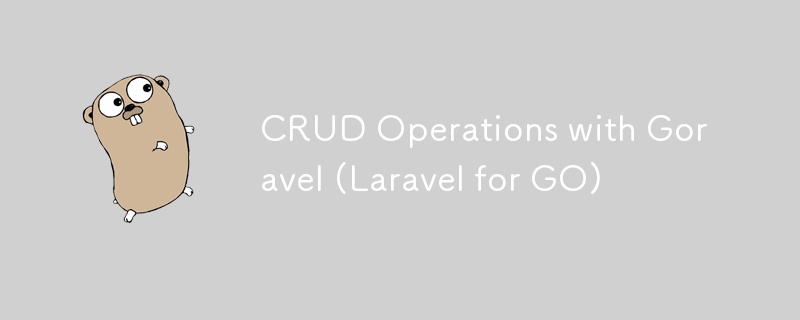
고라벨 소개
Goravel은 Gopher가 자신만의 애플리케이션을 빠르게 구축할 수 있도록 돕는 시작 발판으로서 완벽한 기능과 뛰어난 확장성을 갖춘 웹 애플리케이션 프레임워크입니다.
Goravel은 Go 개발자를 위한 Laravel의 완벽한 복제품입니다. 즉, 저와 같은 PHP 개발자는 프레임워크에 쉽게 공감하고 약간의 학습만으로 작성을 시작할 수 있습니다.
설치부터 시작하겠습니다. 이 기사에 따라 Goravel 공식 문서 웹사이트를 설치하거나 방문할 수 있습니다.
// Download framework git clone https://github.com/goravel/goravel.git && rm -rf goravel/.git* // Install dependencies cd goravel && go mod tidy // Create .env environment configuration file cp .env.example .env // Generate application key go run . artisan key:generate //start the application go run .
즐겨 사용하는 텍스트 편집기에서 코드를 열면 프로젝트 구조가 Laravel과 똑같다는 것을 알 수 있으므로 Laravel 개발자는 당황하지 않을 것입니다.
모델, 마이그레이션 및 컨트롤러
모델, 마이그레이션, 컨트롤러를 생성하려면 Laravel에서와 마찬가지로 artisan 명령을 사용할 수 있습니다.
// create model go run . artisan make:model Category // create migration go run . artisan make:migration create_categories_table // create controller go run . artisan make:controller --resource category_controller
이제 데이터베이스/마이그레이션 폴더를 확인하면 up 및 down 파일이 생성된 것을 볼 수 있습니다. up 마이그레이션 파일을 열고 아래 코드를 내부에 붙여넣으세요.
CREATE TABLE categories ( id bigint(20) unsigned NOT NULL AUTO_INCREMENT, name varchar(255) NOT NULL, created_at datetime(3) NOT NULL, updated_at datetime(3) NOT NULL, PRIMARY KEY (id), KEY idx_categories_created_at (created_at), KEY idx_categories_updated_at (updated_at) ) ENGINE = InnoDB DEFAULT CHARSET = utf8mb4;NGINE = InnoDB DEFAULT CHARSET = utf8mb4;
app/http/controllers 폴더 내부를 확인하면 Category_controller.go 파일이 있고 내부 콘텐츠는 아래와 같아야 합니다.
package controllers
import (
"github.com/goravel/framework/contracts/http"
)
type CategoryController struct {
//Dependent services
}
func NewCategoryController() *CategoryController {
return &CategoryController{
//Inject services
}
}
func (r *CategoryController) Index(ctx http.Context) http.Response {
return nil
}
func (r *CategoryController) Show(ctx http.Context) http.Response {
return nil
}
func (r *CategoryController) Store(ctx http.Context) http.Response {
return nil
}
func (r *CategoryController) Update(ctx http.Context) http.Response {
return nil
}
func (r *CategoryController) Destroy(ctx http.Context) http.Response {
return nil
}
그런 다음 app/http/model 내에서 카테고리 모델 파일을 찾은 후 아래 코드를 붙여넣으세요.
package models
import (
"github.com/goravel/framework/database/orm"
)
type Category struct {
orm.Model
Name string
}
여기서는 별다른 일이 없으며, 데이터 유형으로 채울 수 있는 항목을 선언하고 있습니다.
라우트 폴더에서 api.php 파일을 찾아 아래와 같이 코드를 업데이트해 보겠습니다.
package routes
import (
"github.com/goravel/framework/facades"
"goravel/app/http/controllers"
)
func Api() {
userController := controllers.NewUserController()
facades.Route().Get("/users/{id}", userController.Show)
//Resource route
categoryController := controllers.NewCategoryController()
facades.Route().Resource("/category", categoryController)
}
이제 Category_controller.go 파일 내에서 가져오기를 업데이트하고 아래와 같이 업데이트하겠습니다.
import ( "goravel/app/models" "github.com/goravel/framework/contracts/http" "github.com/goravel/framework/facades" )
방금 모델과 파사드를 가져왔습니다. 파사드를 사용하면 유효성 검사, orm 등과 같은 멋지고 유용한 것들에 액세스할 수 있습니다. orm은 GO용 ORM입니다.
코드를 작성할 시간입니다!
컨트롤러의 메소드를 아래 코드로 업데이트하겠습니다.
색인 방법
// this is just to pull all categories in our database
func (r *CategoryController) Index(ctx http.Context) http.Response {
var categories []models.Category
if err := facades.Orm().Query().Find(&categories); err != nil {
return ctx.Response().Json(http.StatusInternalServerError, http.Json{
"error": err.Error(),
})
}
return ctx.Response().Success().Json(http.Json{
"success": true,
"message": "Data fetch successfully",
"data": categories,
})
}
저장방법
func (r *CategoryController) Store(ctx http.Context) http.Response {
// validate the input name that the user is passing
validation, err := facades.Validation().Make(ctx.Request().All(), map[string]string{
"name": "required|string",
})
// check if an error occured, might not be validation error
if err != nil {
return ctx.Response().Json(http.StatusInternalServerError, http.Json{
"success": false,
"message": "Validation setup failed",
"error": err.Error(),
})
}
// check for validation errors
if validation.Fails() {
return ctx.Response().Json(http.StatusBadRequest, http.Json{
"success": false,
"message": "Validation failed",
"errors": validation.Errors().All(),
})
}
// Create the category
category := &models.Category{
Name: ctx.Request().Input("name"),
}
// save the category and return error if there is any
if err := facades.Orm().Query().Create(category); err != nil {
return ctx.Response().Json(http.StatusInternalServerError, http.Json{
"success": false,
"errors": err.Error(),
})
}
// upon successfull creation return success response with the newly created category
return ctx.Response().Success().Json(http.Json{
"success": true,
"message": "Category created successfully",
"data": category,
})
}
업데이트 방법
func (r *CategoryController) Update(ctx http.Context) http.Response {
validation, err := facades.Validation().Make(ctx.Request().All(), map[string]string{
"id": "required",
"name": "required|string",
})
if err != nil {
return ctx.Response().Json(http.StatusInternalServerError, http.Json{
"success": false,
"message": "Validation setup failed",
"error": err.Error(),
})
}
if validation.Fails() {
return ctx.Response().Json(http.StatusBadRequest, http.Json{
"success": false,
"message": "Validation failed",
"errors": validation.Errors().All(),
})
}
// find the category using the id
var category models.Category
if err := facades.Orm().Query().Where("id", ctx.Request().Input("id")).First(&category); err != nil {
return ctx.Response().Json(http.StatusNotFound, http.Json{
"success": false,
"message": "Category not found",
})
}
// update or return error if there is any
category.Name = ctx.Request().Input("name")
if err := facades.Orm().Query().Save(&category); err != nil {
return ctx.Response().Json(http.StatusInternalServerError, http.Json{
"success": false,
"message": "Failed to update category",
"error": err.Error(),
})
}
// return success if successfull
return ctx.Response().Success().Json(http.Json{
"success": true,
"message": "Category updated successfully",
"data": category,
})
}
파기방법
func (r *CategoryController) Destroy(ctx http.Context) http.Response {
// find the category by id
var category models.Category
facades.Orm().Query().Find(&category, ctx.Request().Input("id"))
res, err := facades.Orm().Query().Delete(&category)
// return error if there is any
if err != nil {
return ctx.Response().Json(http.StatusInternalServerError, http.Json{
"error": err.Error(),
})
}
// return success if successfull
return ctx.Response().Success().Json(http.Json{
"success": true,
"message": "Category deleted successfully",
"data": res,
})
}
이제 데이터베이스를 설정해야 합니다. 저는 MySQL을 사용할 것입니다. 여러 데이터베이스 드라이버가 함께 제공된다는 점에 유의하는 것이 중요합니다. .env 파일을 찾아 아래 줄을 편집하세요.
DB_CONNECTION=mysql DB_HOST=127.0.0.1 DB_PORT=3306 DB_DATABASE=DATABASE_NAME DB_USERNAME=DATABASE_USERNAME DB_PASSWORD=DATABASE_PASSWORD
그런 다음 터미널에 다음을 입력하세요.
go run . artisan migrate
이렇게 하면 DB의 카테고리 테이블이 자동으로 마이그레이션됩니다.
이제 이전에 실행 중이던 서버를 중지하고 다시 시작해야 합니다.
이제 Postman에서 엔드포인트를 테스트할 수 있습니다. 카테고리 엔드포인트에 리소스를 추가하면 이제 카테고리 엔드포인트에 대한 GET, POST, PUT 또는 DELETE 메서드에 액세스할 수 있다는 점에 유의해야 합니다. 다음과 같은 방법으로 엔드포인트에 액세스할 수 있습니다.
// GET category
http://localhost:3000/category
//POST catgory - with payload
http://localhost:3000/category
{
"name": "goravel"
}
// PUT category - with payload
http://localhost:3000/category/{id}
{
"id": 1,
"name": "laravel"
}
//DELETE category
http://localhost:3000/category/{id}
Goravel을 사용하여 간단한 CRUD 작업을 수행하는 방법입니다.
위 내용은 Goravel을 사용한 CRUD 작업(GO용 Laravel)의 상세 내용입니다. 자세한 내용은 PHP 중국어 웹사이트의 기타 관련 기사를 참조하세요!